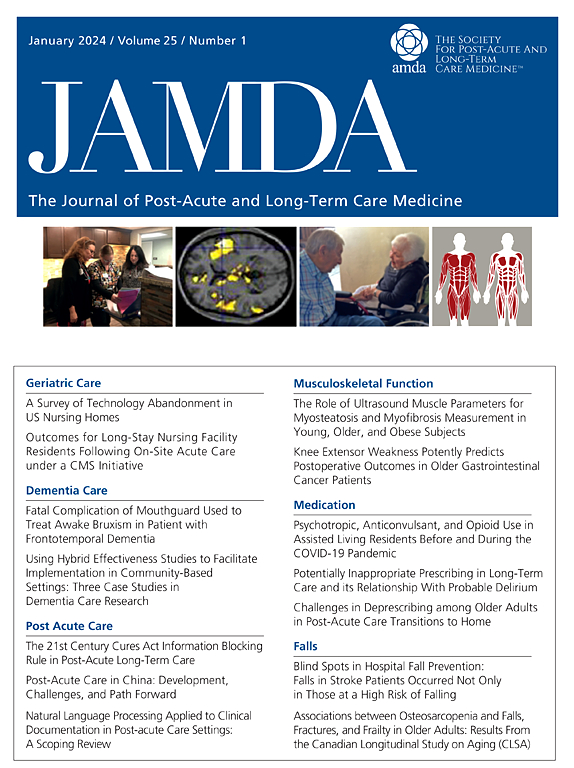性别特异性下降轨迹和相关的自我报告风险因素:为期3年的5个国家DO-HEALTH试验的前瞻性分析
IF 4.2
2区 医学
Q2 GERIATRICS & GERONTOLOGY
Journal of the American Medical Directors Association
Pub Date : 2025-03-20
DOI:10.1016/j.jamda.2025.105542
引用次数: 0
摘要
目的:很少有研究探索老年人跌倒的具体轨迹或模式,性别和自我报告的风险因素在这些轨迹中的作用被忽视了。本研究旨在确定欧洲老年人在3年内不同性别的跌倒轨迹,以及与每个轨迹相关的自我报告风险因素。设计:DO-HEALTH的观察性分析,双盲、随机对照试验。环境和参与者:在7个欧洲中心进行的多中心试验:苏黎世、巴塞尔、日内瓦(瑞士)、柏林(德国)、因斯布鲁克(奥地利)、图卢兹(法国)和科英布拉(葡萄牙),包括2157名70岁及以上的社区居民,入组前5年内没有重大健康事件,有足够的活动能力和良好的认知状况。方法:在3年的随访中,每3个月通过电话和面对面评估记录跌倒情况。基于群体的轨迹模型用于根据随访期间经历的跌倒次数确定性别特定的轨迹,惩罚逻辑回归模型确定与每个轨迹最相关的自我报告风险因素。结果:共有1958名参与者被纳入本分析(平均年龄:74.9岁,61.7%为女性)。我们确定了女性的“低跌落轨迹”和“高跌落轨迹”,男性的“低跌落轨迹”和“高跌落轨迹”。在女性中,独居是唯一与较高跌倒轨迹相关的自我报告风险因素。在男性中,独居(边缘),以及报告疲劳、疼痛或不适、行动能力问题和较高的自我评价健康,与经历越来越多的跌倒轨迹显著相关。结论和意义:这项研究提供了3年来跌倒的综合评估,突出了男性和女性之间跌倒模式和相关自我报告风险因素的差异。这些发现可能为开发基于性别的跌倒风险预测模型和有针对性的跌倒预防策略提供有价值的见解。本文章由计算机程序翻译,如有差异,请以英文原文为准。
Sex-Specific Fall Trajectories and Associated Self-Reported Risk Factors: A Prospective Analysis of the 3-Year 5-Country DO-HEALTH Trial
Objective
Few studies have explored specific trajectories or patterns of falls over time in older adults, and the role of sex and self-reported risk factors for these trajectories were overlooked. This study aimed to identify sex-specific fall trajectories over 3 years and the self-reported risk factors associated with each trajectory in European older adults.
Design
Observational analysis of DO-HEALTH, a double-blind, randomized controlled trial.
Setting and Participants
Multicenter trial conducted in 7 European centers: Zurich, Basel, Geneva (Switzerland), Berlin (Germany), Innsbruck (Austria), Toulouse (France), and Coimbra (Portugal), including 2157 community-dwelling adults aged 70 years and older without major health events in the 5 years prior to enrollment, with sufficient mobility and good cognitive status.
Methods
Falls were recorded prospectively via phone calls and in-person assessments every 3 months over 3 years of follow-up. Group-based trajectory modeling was used to identify sex-specific trajectories based on the number of falls experienced over the follow-up, and penalized logistic regression models identified the self-reported risk factors most associated with each trajectory.
Results
A total of 1958 participants were included in this analysis (mean age: 74.9 years, 61.7% women). We identified a “lower fall trajectory” and a “higher fall trajectory” among women and a “lower fall trajectory” and an “increasing fall trajectory” among men. In women, living alone was the only self-reported risk factor associated with the higher fall trajectory. In men, living alone (marginal), as well as reporting fatigue, pain or discomfort, mobility issues, and higher self-rated health, were significantly associated with experiencing the increasing fall trajectory.
Conclusions and Implications
This study provides a comprehensive assessment of falls over 3 years, highlighting differences in fall patterns and associated self-reported risk factors between men and women. These findings may offer valuable insights for developing sex-specific fall risk prediction models and targeted fall prevention strategies.
求助全文
通过发布文献求助,成功后即可免费获取论文全文。
去求助
来源期刊
CiteScore
11.10
自引率
6.60%
发文量
472
审稿时长
44 days
期刊介绍:
JAMDA, the official journal of AMDA - The Society for Post-Acute and Long-Term Care Medicine, is a leading peer-reviewed publication that offers practical information and research geared towards healthcare professionals in the post-acute and long-term care fields. It is also a valuable resource for policy-makers, organizational leaders, educators, and advocates.
The journal provides essential information for various healthcare professionals such as medical directors, attending physicians, nurses, consultant pharmacists, geriatric psychiatrists, nurse practitioners, physician assistants, physical and occupational therapists, social workers, and others involved in providing, overseeing, and promoting quality

 求助内容:
求助内容: 应助结果提醒方式:
应助结果提醒方式:


